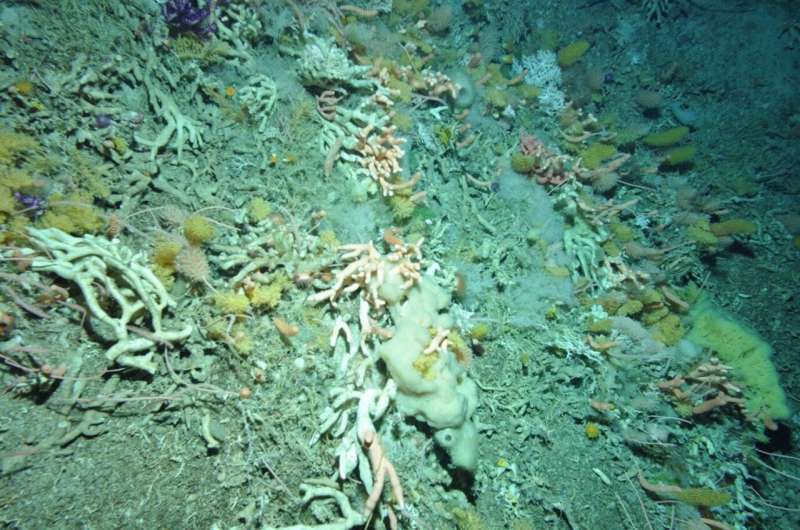This article has been reviewed according to Science X's editorial process and policies. Editors have highlighted the following attributes while ensuring the content's credibility:
fact-checked
peer-reviewed publication
trusted source
proofread
Study of deep-sea corals reveals ocean currents have not fueled rise in atmospheric carbon dioxide

Pioneering analysis of deep-sea corals has overturned the idea that ocean currents contributed to increasing global levels of carbon dioxide in the air over the past 11,000 years.
The study, led by the University of Bristol in the UK and Nanjing University in China, examined historic deep-sea corals to shed intriguing new light on the history of ocean chemistry.
Understanding what has led to the pre-industrial rise in carbon dioxide (CO2) levels during the Holocene period, which dates back some 11,700 years to the present day, is a source of scientific debate. One theory suggests the increase in physical upwelling of carbon-rich deep waters to the surface of the Southern Ocean, in other words changes in high-latitude ocean circulation, may have triggered the release of marine carbon into the atmosphere, although this is not fully understood.
Lead author Tianyu Chen, Professor of Marine Geochemistry at Nanjing University and the University of Bristol, said, "Our research challenges assumptions about the role of ocean circulation in the carbon cycle during the Holocene. By providing radiocarbon evidence for the stability of these processes, we pave the way for a deeper understanding of the complex interactions between the ocean and the Earth's climate system."
The Holocene, which followed the retreat of major ice sheets in the Northern Hemisphere, is the Earth's most recent interglacial period and has long intrigued scientists studying Earth's recent climate history. A key aspect of this period is the rise in atmospheric CO2 levels. Initially, in the early Holocene, CO2 levels were approximately 260 parts per million by volume (ppmv). However, over the course of around 5,000 years they increased by 20 ppmv, equivalent to around 150 gigatons of CO2.
Corals are remarkable organisms, which have thrived on seamounts over the course of the Holocene. The international team of researchers meticulously dated deep sea coral data from the Drake Passage, located between South American and Antarctica, as well as the Reykjanes Ridge, south of Iceland, from this period. These corals live at water depths stretching 1,900 meters within Antarctic circumpolar waters and North Atlantic Deep Water.
Surprisingly, the radiocarbon data suggested ventilation in the Antarctic circumpolar waters and North Atlantic Deep Water remained relatively stable.
The findings, published in Nature Geoscience, indicate long-term polar ocean mixing between surface and deep water, on the millennial scale, did not undergo significant disturbances. Consequently, it suggests the North Atlantic and Southern Ocean circulation alone did not drive the rise of atmospheric CO2 levels during the Holocene. Instead, the researchers propose biogeochemical cycles that redistribute nutrients and carbon in the ocean and on land may have influenced this rise.
Co-author Dr. Joseph Stewart, Research Fellow in Geochemistry at the University of Bristol, said, "Thanks to the decay of radioactive isotopes within their skeletons, deep-sea corals effectively contain two 'clocks.' Trace amounts of uranium-238 within the corals gradually decays to thorium-230 allowing us to accurately assess their age by measuring this isotope ratio.
"The second clock, radiocarbon (carbon-14) also slowly decays away, however it predominantly enters the oceans via the atmosphere. The radiocarbon content of corals therefore tells us how long radiocarbon-depleted deep waters have been out of contact with radiocarbon-rich surface waters. By using both 'clocks' together we were able to assess the rates of ocean ventilation during this key interval."
This study represents an important step forward in unraveling the relationship between ocean circulation, carbon cycling, and climate dynamics during the Holocene. A future comprehensive understanding of natural and human-induced variations in carbon cycle will be essential to fully comprehend the Holocene atmosphere's carbon budget.
Co-author Laura Robinson, Professor of Geochemistry at the University of Bristol, added, "These findings contribute to the growing body of knowledge in this field and underscore the importance of further exploring the mechanism that decouples the biogeochemical cycle and physical ocean circulation during the Holocene."
More information: Tianyu Chen, Radiocarbon evidence for the stability of polar ocean overturning during the Holocene, Nature Geoscience (2023). DOI: 10.1038/s41561-023-01214-2. www.nature.com/articles/s41561-023-01214-2
Journal information: Nature Geoscience
Provided by University of Bristol



















